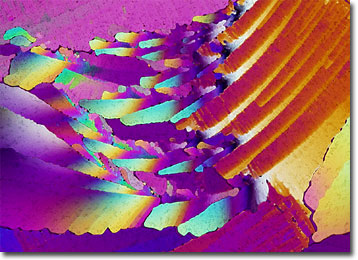Polarized Light Microscopy Digital Image Gallery
Succinimide
Epilepsy has been recognized for more than 2,000 years, but it was known for a long period of time as the “falling sickness” because those suffering from characteristic attacks or seizures usually fell to the ground suddenly. Though it can be severe and debilitating at times, epilepsy does not necessarily preclude individuals from leading very productive lives, and a number of extremely successful people, such as Julius Caesar, Socrates, Lord Byron, and Vincent van Gogh, have been afflicted with the condition.

View a second image of Succinimide
Treatment for epilepsy has varied greatly throughout history. In the earliest times, when people generally believed the illness was brought about by the gods, treatment consisted of sacrifices, offerings to the gods, and other religious acts. Similar practices were utilized in the Middle Ages by Christians, who often prayed to saints, fasted, and undertook pilgrimages seeking relief. Other types of early treatment included dietetic therapy, consumption of mugwort, peony, absinth, or castoreum, and superstitious practices, such as the casting of spells and the wearing of protective amulets. It was not until the latter half of the nineteenth century that more effective medical means of treating epilepsy were developed. Today, however, more than 20 chemical substances are known to effectively combat epileptic seizures, including succinimide, which was first utilized in the United States during the 1960s.
Succinimide is a diketopyrrolidine that is prepared by rapid distillation of ammonium succinate. It and other modern anticonvulsants commonly utilized to treat epileptics generate their beneficial effects by acting on the central nervous system, which generally reduces the severity and frequency of seizures. Obtainable only by prescription and often more commonly known by the brand names Celontin and Zarontin, succinimide is available in both capsule and syrup form for oral consumption. In order for the medication to be effective, it must be consumed on a regular basis and in the proper dosage, which is often difficult to determine and may require several visits to the doctor to establish. Similar to most other drugs, a number of side effects may occur with succinimide treatment, the most common of which are nausea, vomiting, hiccups, drowsiness, and headache. Rare, but much more serious, side effects include wheezing, swollen glands, bruising, chest pain, and increased seizure activity.
